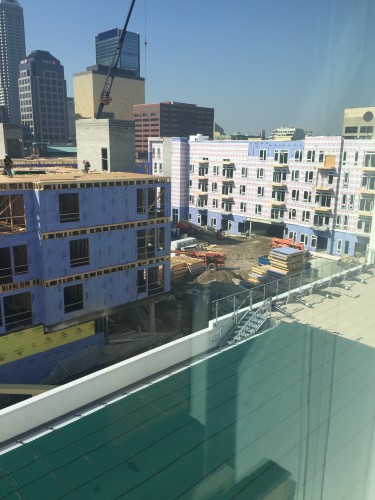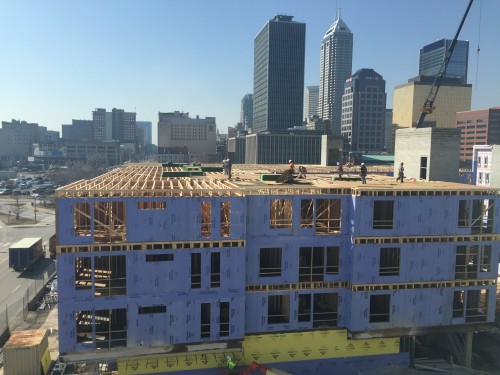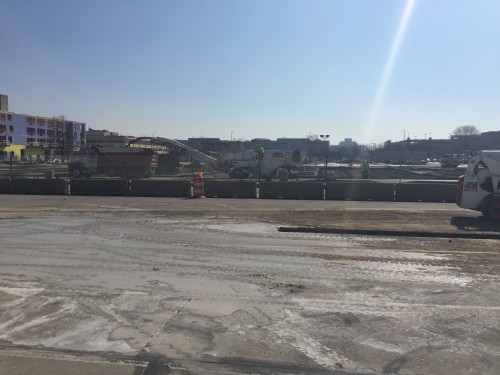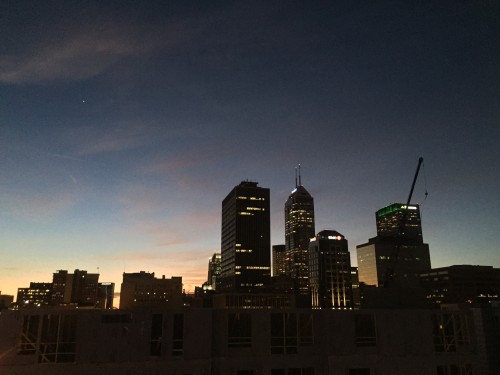What happens when a city adds a lot of residents to its downtown that are really eager to be there? What happens when a city adds hundreds and thousands of new residents to an area that is 5 minutes walk from the center of the city, 5 minutes walk from the bustling trendy area with many shops, restaurants and places to congregate? Or how about being a 10 minute walk or 5 minute bike ride from another trendy area along a world-class protected bike and pedestrian pair of great looking paths? What you get is a district of Indy called Market East.
I now call myself a resident of this area of downtown Indianapolis and can speak to its tremendous location. I walk my dog twice a day around here and can attest to being able to get to everything I need, on foot. How many desirable US downtowns can claim this distinction? Indy has the good fortune of already being a very compact downtown, in contrast to most of the rest of the county that it resides in. This has been working out nicely for the Market East district, which even 2 years ago was still a decrepit old factory and large surface parking lots for commuters working downtown. Now it’s turning into a fantastic place to work, to live and to socialize. The Artistry apartments, along with the second phase called Mentor/Muse, are great apartment communities with nice amenities like an outdoor infinity pool, outdoor kitchen, bocce ball, putting green, community garden, fantastic pair of workout rooms, etc. They accommodate bikes well, they have wide sidewalks around them and they’ve even done car parking well with a nicely hidden two-level garage.
What does this have to do with urban experiment? Market East is a poster-child for what happens when all elements of what humans need begin to present themselves. It’s a walkable/bikeable area thanks to sidewalks, fairly reasonable street design that aren’t that somewhat avoids super wide highway-like stroads, it has easy access thanks to its proximity to shops, restaurants and green spaces, and has needed minimal prodding from the city. The Indianapolis Cultural Trail is largely responsible for a resurgence of many parts of downtown because it brought pedestrians who pop into shops and restaurants much more frequently than commuters or people passing through by car. When you walk or bike next to things which are both at human speeds instead of racing through locked in a car, you tend to much more easily involve yourself in the built environment of areas as well as care for/about these areas. As someone who just moved from a much more car-centric part of Indianapolis, I can attest to this.
To sum this all up, a place becomes very desirable and very valuable once it is built to accommodate humans first. This is a lesson that Market East clearly demonstrates as a new 28 story apartment building with Whole Foods gets built and a very nicely integrated 10 story Cummins office building with mixed retail space gets built in this area. These will make Market East even more desirable because both projects focus on people living and working and not only commuting by car. They are not a small leap, but it was the small improvements like the Cultural Trail and more residents that made these projects natural larger steps in order to evolve an exciting part of downtown Indy. I look forward to seeing what else this district evolves into once these projects complete and more people than ever work and live here in this district.
This was originally posted at Little Urban Experiments







You forgot one big thing, design
Care to expound upon what you mean more specifically?
“it has easy access thanks to its proximity to shops, restaurants and green spaces, and has needed minimal prodding from the city.”
Not too much prodding but a substantial amount of TIF monies to cover development costs.
Also, the Cultural Trail was a significant investment ($60M), with a large part of it coming from a federal grant.
So, yes, the area is revitalizing and that’s great, but it has been heavily supported by the City of Indianapolis.
And I agree; the design of many of these developments is not aesthetically pleasing, particularly the apartment buildings. Density is good though and so we’ll deal with cheap downtown developers to get the buildings.
“Also, the Cultural Trail was a significant investment ($60M), with a large part of it coming from a federal grant.”
Yes indeed, although I think it was a really good public-private partnership example [1]. Any idea if it was the idea of one or more private financiers or was it straight up the city’s idea?
I rather like the apartment building designs as they’re very clean and minimal in design – much like many very attractive buildings in Scandinavian cities like Copenhagen which of course is known for being very architecturally pleasing [2]. Could Indy do better, absolutely, but I’m a strong believer in evolutionary steps to development. These are beginning to give downtown the needed population density in order to get to the next level of activating downtown for more than just work and driving in for quick entertainment.
[1] http://indyculturaltrail.org/about/faq/
[2] http://1.bp.blogspot.com/_RVFF_AxuzbE/TK4P9thKuzI/AAAAAAAAAX4/IpGOhLaOaL8/s1600/DSCF1797.JPG
The idea for the Trail is credited to Brian Payne who wanted to replicate in downtown the vibrancy created on the Monon Trail he observed in the SoBro/Broad Ripple area. Once the Cultural Districts were established this project was tagged by some as the answer to “what next?” So it wasn’t driven by an existing source of $ but rather the desire to continue to make the downtown urban environment more appealing by providing a physical connection between Cultural Districts, attractions, sporting event venues etc.
That’s awesome, thanks for sharing that. What a great vision and it’s exciting to see that vision generally be true – maybe even beyond Brian’s wildest dream.
While Copenhagen is renowned for it’s minimalistic modern design, especially in architecture, I feel like a lot of these Market East developments are a sort of “ugly cousin” to that style. What sets Copenhagen apart as well is the historical architecture (of varying styles) juxtaposed with the modern, “Scandi-chic” across the city. Not to mention well developed, dense, mixed-use, bicycle/transit oriented public spaces and streetscapes.
*Side note: That photo is showing the Bo01 development in Malmö, Sweden, just across the Øresund from Copenhagen. Essentially a suburb of Copenhagen, these developments typically have less of a well-received reputation from residents of the immediate and surrounding area. It’s quite weird how different things feel once you cross the bridge into Sweden, actually.
I don’t mean to sound harsh or like I’m complaining about the progress these long-standing pavement wastelands are seeing, like you said Jim, its a step. A good first step in the right direction and I am excited to see what else might spring up in the area from these efforts!
Mr. Hodapp do you work for the Artistry? Your quite the cheerleader for a blah design and use of materials.
I do not, I just moved here so that’s the source of enthusiasm. Indy needs cheerleaders for things that are moving in the right direction. Is the Artistry an amazingly gorgeous innovative apartment complex? Certainly not. But it’s adding a whole lot of density to a great part of downtown where a great majority of its residents walk and bike to work, to shops and all around the city. How can you not cheer that on? Indy’s been missing that for so long. This just happens to be where my frame of reference is from, so if I had moved to the Axis, or 9 On Canal, or whatever new developments, unless they were atrocious failures to live in, I’d be singing their praises too.
We have plenty of cheerleaders and always have. What we need more of are caring, informed, critical thinkers who challenge the excessive tolerance for average that is still too far pervasive in our design and urban placemaking. it’s the only way we will get really good or great results instead of “just good enough.”
I would tend to disagree that there are a lot of cheerleaders. I think there’s a lot of people who like it here because it generally stays the same and they like and are comfortable with the status quo. I hear a lot of people say that they can’t wait to move out of Indy, but more specifically Indiana, because it lacks. I rarely hear someone say that they love living here. Having grown up in Wisconsin, I know the difference here. Many people (not everyone) love living in Wisconsin for many different reasons ranging from the natural beauty of the state, to some great cities and small towns, to great European ethnic heritage, etc. Where are these cheerleaders that you speak of who genuinely love living here?
Check the hashtag #loveindy and you’ll see people public cheerleading on a regular basis. And true to our humble Hoosier form, much of the cheerleader goes on in quieter ways in neighborhood forums and placemaking meetings where real work to make Indy better occurs. And to some extent, the # of people moving downtown are cheerleading with their location/relocation choices.
The aesthetic appearance and architectural design of these structures, like many in the area, have been, are and will be subjective. This is a constant point of discussion regarding development in this city, and most others. IMO, I’d prefer a different style of building than what is presented in the Artistry as well as phase II. These would have been great opportunities to clad buildings in glass and steel to really make the district stand out. I do like the addition of color to buildings, which is a nice contrast to the many limestone and brick structures downtown.
I do have large concerns over the actual material and structural quality of these and many other structures. I can’t believe for a minute that someone can honestly say a wood-framed, quickly-built structure with prefabricated panels and siding will stand the test of time. I guess we will find out, but as prices continue to rise for rents and commercial space leases up, I believe we will see improvements to quality as well.
What is far more difficult to argue is the success of urban design. Though it was not a design, and more than likely forced by code and cost considerations, the 5-story structures, divided into three separate buildings create a great, human-scaled mass on this block, and eventually along the parking garage. Too often we find a building consume an entire block with a monolithic structure that pretends to be individual store fronts with little success. These structures have introduced ground floor office/retail, art space, leasing offices, well-integrated parking garages and great amenities for tenants. With assistance (significant) from the City, the streetscape of Market Street will finally see investment worthy of its history and prominence. The development of Cummins, itself a relatively modern building, will inject great day-time vitality in the district. The modern 28-story tower will provide a residential experience somewhat unmatched in the state. Yes, we have Riley Towers, but they certainly show their age.
After a development process that has seemingly taken forever since the implosion, it has been only a few short years to grow from an abandoned, poor representation of the urban environment to adding nearly 1,000 residential units, consolidating employees for a Fortune 500 company and luring office tenants from Greenwood with a new tenant to be announced soon.
I completely agree with your comments. One may not completely be in love with the look of the Artistry, or phase II of the site with Mentor/Muse. But your point about the human-scaled success of these projects is spot on. There’s only one company using the retail space underneath the Artistry at the moment (StreetLinks), but I believe when this area starts to stabilize in construction a bit, shops and restaurants are likely to move in. But even until then, these apartments are a great place to call home location-wise because you can walk/get to just about anything in the entire center area of Indy.
I can attest to the very quick and low quality of the units though. I am disappointed that Milhaus chose to build these out of stick frame construction and not at least with metal studs, or built out of concrete or the like. These buildings are supposedly Leed certified, but that might not be saying much.
I really think that these buildings are not meant to “stand the test of time”, but more be a placeholder for the next 20 or so years until the density is such to build larger, higher-density buildings.
Agreed. And I think that’s totally reasonable and a very sustainable way of having a city grow up because it reduces risk on taking giant leaps (which can be fun, but like I said are hugely risky).
Back in the “oldern” days, the typical development of a commercial plat was as follows:
1) Set up a tent to hock your wares.
2) Upgrade to a lean-to.
3) Upgrade to a single story wood frame structure
4) Replace with a two story brick live/work structure.
To update that to modern terms, it looks something like this:
1) Vacant lot.
2) Parking lot.
3) Low-rise wood frame apartment building.
4) Mid-rise concrete building.
5) High-rise glass and steel building.
Of course the second set doesn’t happen on the same lot linearly, but happens around a neighborhood as it comes up and infills. Also, that list doesn’t include subsidy driven development like the Market Tower high-rise.
Jim hodapp you’re right on with your statements about density /artistry ect.and indy needing them for a long time, And yes better than what was their befor and those parking lots. I personally think two twin 35 story one restden,and one hotel with restden,mixed use with sky bridge and mini park art work etc. should had gone on the msa site Just picture those two towers across from eachother with that enclosed sky walk. my opion just saying.
I like the twin towers idea, but I’d do without the skywalk. Those just take foot traffic off the street and put it in a hamster tube.
Thanks Anthony. I wouldn’t mind a couple of 35 story towers but I agree with ahow628 that we don’t need the sky bridge. We want to keep the streets activated with people and activity beyond just cars, so that’s why I wouldn’t want to see the sky bridges. Thanks for reading.
“How many desirable US downtowns can claim this distinction?”
As a 20+ year downtown resident, I appreciate this post and your enthusiasm for Market East. But as someone who historically has traveled to 50+ good-sized cities a year for work, I would answer “most of them.”
Much of what is happening in Indy has already happened or is also happening in other comparable second-tier cities, as well as third-tier cities using what we have done as a model to launch their own downtown revitalization.
I don’t mean this to be negative, but much of what is happening in Indy is exactly what is supposed to happen to create a vibrant urban core.
For a number of things on the list, I would tend to agree, but Indy has something not even most first-tier US cities have: the Cultural Trail. Chicago and LA don’t have anything remotely close to it. NYC has the High Line and pedestrianized Times Square, but neither of those are very similar. Does anywhere have a Cultural Trail equivalent? River Walk in San Antonio is the closest thing I can come up with.
Totally agree and I would add that Indy has a compact and very walkable downtown that other cities just don’t have because they’re large (e.g. Chicago) or just not compact enough (e.g. Milwaukee). Marion county is anything but compact, but downtown definitely is. I would love for it to be even more compact like in the style of an old European city, but of course we have what we have now.
It may sound like I am splitting hairs here, but I’d suggest looking for urban equivalents to the Cultural Trail is unhelpful. The Cultural Trail works so well here because of the compact nature of downtown and the way the urban core is lined with smaller neighborhoods. The Trail leverages the space between those elements and unites them in a distinctive way just as the Highline leverages the unused track in NYC and takes you on a walking tour above multiple neighborhoods.
For me the question would be more: how are comparable (however you want to define that) cities creating a distinctive element that leverages what is unique (good or bad) about their space and culture? So in Minneapolis it might be the trails that link many of their urban lakes and parks together.
You’er very much welcomed Jim Hodapp, Also very glad that you and ahow 628 Approved of the twin towers idea even though i still think sky bridges/walks look cool and give that big city urban city chick look,they also keep you cool in the summer and warm in the winter as well,many cities big and small have them.minnapolis,houston etc.However whats going in now ,just doesnt strike me as spectacular as for what the mayors desires called for, but still ok to nice in my opinion.